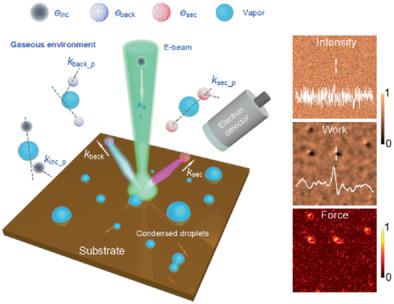Our official English website, www.x-mol.net, welcomes your
feedback! (Note: you will need to create a separate account there.)
Quasi‐Newtonian Environmental Scanning Electron Microscopy (QN‐ESEM) for Monitoring Material Dynamics in High‐Pressure Gaseous Environments
Advanced Science ( IF 14.3 ) Pub Date : 2020-08-18 , DOI: 10.1002/advs.202001268 Jinlong Zhu 1 , Lenan Zhang 2 , Xiangyu Li 2 , Kyle L Wilke 2 , Evelyn N Wang 2 , Lynford L Goddard 1
Advanced Science ( IF 14.3 ) Pub Date : 2020-08-18 , DOI: 10.1002/advs.202001268 Jinlong Zhu 1 , Lenan Zhang 2 , Xiangyu Li 2 , Kyle L Wilke 2 , Evelyn N Wang 2 , Lynford L Goddard 1
Affiliation

|
Environmental scanning electron microscopy (ESEM) is a powerful technique that enables imaging of diverse specimens (e.g., biomaterials, chemical materials, nanomaterials) in a hydrated or native state while simultaneously maintaining micro‐to‐nanoscale resolution. However, it is difficult to achieve high signal‐to‐noise and artifact‐free secondary electron images in a high‐pressure gaseous environment due to the intensive electron‐gas collisions. In addition, nanotextured substrates can mask the signal from a weakly scattering sample. These drawbacks limit the study of material dynamics under extreme conditions and correspondingly our understanding in many fields. In this work, an imaging framework called Quasi‐Newtonian ESEM is proposed, which introduces the concepts of quasi‐force and quasi‐work by referencing the scattering force in light–matter interactions, to break these barriers without any hardware changes. It is shown that quasi‐force is a more fundamental quantity that has a more significant connection with the sample morphology than intensity in the strongly scattering regime. Experimental and theoretical studies on the dynamics of droplet condensation in a high‐pressure environment (up to 2500 Pa) successfully demonstrate the effectiveness and robustness of the framework and that the overwhelmed signal of interest in ESEM images can be reconstructed through information stored in the time domain, i.e., frames captured at different moments.
中文翻译:

用于监测高压气体环境中材料动力学的准牛顿环境扫描电子显微镜 (QN-ESEM)
环境扫描电子显微镜 (ESEM) 是一种强大的技术,可以对水合或天然状态下的各种样本(例如生物材料、化学材料、纳米材料)进行成像,同时保持微米到纳米级的分辨率。然而,由于强烈的电子-气体碰撞,在高压气体环境中很难获得高信噪比和无伪影的二次电子图像。此外,纳米纹理基材可以掩盖弱散射样品的信号。这些缺点限制了极端条件下材料动力学的研究以及相应地我们在许多领域的理解。在这项工作中,提出了一种称为准牛顿ESEM的成像框架,该框架通过参考光与物质相互作用中的散射力引入了准力和准功的概念,从而在不改变任何硬件的情况下打破这些障碍。结果表明,准力是一个更基本的量,与强散射区域中的强度相比,它与样品形态的关系更显着。对高压环境(高达 2500 Pa)中液滴凝结动力学的实验和理论研究成功证明了该框架的有效性和鲁棒性,并且可以通过存储在时间中的信息来重建 ESEM 图像中被淹没的感兴趣信号域,即在不同时刻捕获的帧。
更新日期:2020-10-07
中文翻译:

用于监测高压气体环境中材料动力学的准牛顿环境扫描电子显微镜 (QN-ESEM)
环境扫描电子显微镜 (ESEM) 是一种强大的技术,可以对水合或天然状态下的各种样本(例如生物材料、化学材料、纳米材料)进行成像,同时保持微米到纳米级的分辨率。然而,由于强烈的电子-气体碰撞,在高压气体环境中很难获得高信噪比和无伪影的二次电子图像。此外,纳米纹理基材可以掩盖弱散射样品的信号。这些缺点限制了极端条件下材料动力学的研究以及相应地我们在许多领域的理解。在这项工作中,提出了一种称为准牛顿ESEM的成像框架,该框架通过参考光与物质相互作用中的散射力引入了准力和准功的概念,从而在不改变任何硬件的情况下打破这些障碍。结果表明,准力是一个更基本的量,与强散射区域中的强度相比,它与样品形态的关系更显着。对高压环境(高达 2500 Pa)中液滴凝结动力学的实验和理论研究成功证明了该框架的有效性和鲁棒性,并且可以通过存储在时间中的信息来重建 ESEM 图像中被淹没的感兴趣信号域,即在不同时刻捕获的帧。










































 京公网安备 11010802027423号
京公网安备 11010802027423号